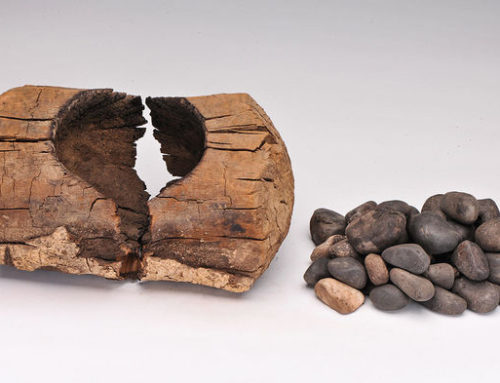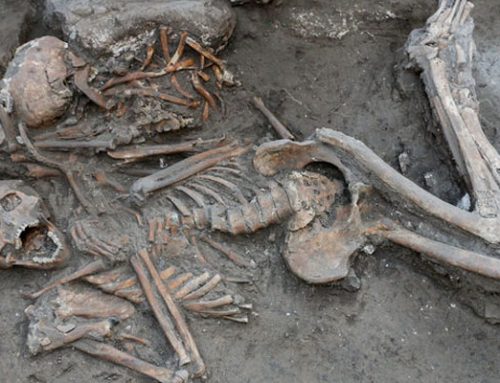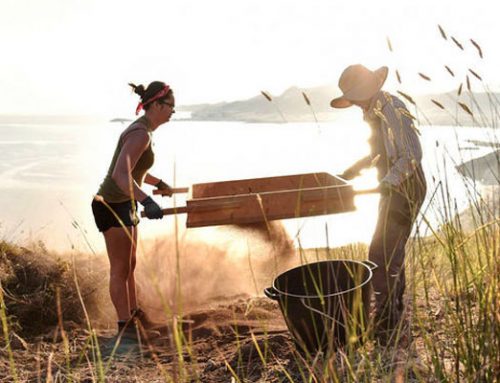EAST ST. LOUIS, ILLINOIS—Today, this city block is a vast, weedy lot next to a highway in a depressed industrial town. A century ago, it was a notorious red-light district catering to ranchers bringing cattle to a stockyard. But a millennium ago, this strategic spot along the Mississippi River was an affluent neighborhood of Native Americans, set amid the largest concentration of people and monumental architecture north of what is now Mexico.
 |
| Going, going, gone. Workers destroyed the largest St. Louis mound in 1870. |
Back then, hundreds of well-thatched rectangular houses, carefully aligned along the cardinal directions, stood here, overshadowed by dozens of enormous earthen mounds flanked by large ceremonial plazas. To the east was another concentration of mounds and people—the settlement called Cahokia by today’s archaeologists—and to the west across the broad Mississippi was a third center of mounds and houses at what is modern St. Louis. Cahokia proper was the only pre-Columbian city north of the Rio Grande, and it was large even by European and Mesoamerican standards of the day, drawing immigrants from hundreds of kilo•meters around to live, work, and participate in mass ceremonies.
Now the new excavations suggest a far larger, complex metropolis. “It’s an early example of urban sprawl,” says archaeologist Patrick Durst of the Illinois Department of Transportation. He is coordinating more than 50 workers at the East St. Louis dig, who were busy shoveling, mapping, and confer•ring in the hot autumn sun one day this fall. Their work is urgent: A new highway and a bridge over the Mississippi will soon destroy the remnants of the site.
 |
| Rich digs. Work in East St. Louis (above), led by Thomas Emerson and Joseph Galloy (below, left to right), has uncov-ered luxury items like this stone figure (inset). |
 |
The $2.5 million dig is yielding big surprises for researchers, who had thought that the 19th century industrial city here wiped out the ancient remains dating as far back as 1000 C.E. Researchers have long known about the monumental earthen mounds at Cahokia, the primary ceremonial center 10 kilometers to the east, but no one expected to find traces of a large settlement west of that site. Now Durst’s team has uncovered not just house foundations, but incised pottery and exotic goods made of copper, lead, and basalt from distant sources, showing the wealth of the inhabitants. “It’s phenomenal,” says archaeologist John Kelly of Washington University in St. Louis, Missouri, who has worked at Cahokia for more than 4 decades but is not involved in the East St. Louis dig. “We were caught totally off guard.”
The excavations to date suggest that Cahokia was part of a large urban complex, one organized differently from other cities. “This was a metropolitan area,” perhaps home to as many as 50,000 people, “and you were a day’s walk or canoe ride from one end to the other,” says Thomas Emerson of the University of Illinois, Urbana-Champaign, who directs the Illinois Transportation Archaeological Research Program (ITARP). The reach of this metropolis extended for hundreds of kilometers: Other researchers are finding settlements as far north as Wisconsin, apparently established by Cahokians.
The nature of this society’s organization and beliefs, as well as the reasons for its abrupt demise around 1300 C.E., remain hotly debated. A string of new finds from the bayous of Louisiana to the Great Lakes is prompting a mini-renaissance in the field, however, even as new development threatens to destroy ancient settlements (see sidebar, p. 1623). Scientists are also rethinking the evolution of mound-building societies, whose roots stretch back even earlier than the grand civilizations of Mesoamerica (see sidebar, p. 1620). “There’s a growing realization that eastern Native American societies are more complicated and nuanced than previously imagined,” says Tristram R. Kidder, an archaeologist at Washington University in St. Louis. “It’s a different way of thinking.”
An urban phenomenon?
At the core of this new thinking is Cahokia, which lies in the lush American Bottom, a 450-square-kilometer floodplain on the Illi•nois side of the Mississippi River, roughly halfway between the Mississippi’s source and its delta (see map). In the 19th century, this fertile land drew white settlers, who dis•missed the enormous earthen mounds as natural formations or the product of Vikings or the lost tribes of Israel. As recently as the 1950s, a popular scientific theory touted ancient Mayans rather than Native Americans as the mounds’ creators. Mostly, the mounds were ignored and then destroyed.
 |
| Mounds along the Mississippi. Cahokia flour•ished in Illinois’s American Bottom (left inset), but northeastern Louisiana (right inset) is home to the earliest mounds (blue dots). |
By the 1860s, all but one of the 20 mounds in booming St. Louis had been leveled. Just across the river, double that number in East St. Louis were razed as that city began to prosper. In Cahokia, further to the east, more than 100 mounds formed a ceremonial center measuring more than 7 square kilometers; thanks to their more rural location, many of these survived. The largest structure, Monks Mound, named for Trappist brothers who built a 19th century monastery on its side, was at the center of four great plazas and surrounded by ancillary mounds. The monument has a base as large as the Great Pyramid of Giza and a circumference greater than the Pyramid of the Sun at Mexico’s Teotihuacan. Towering 30 meters above the flat landscape and built solely of soil, the rectangular structure was topped with a 30-meter-long by 15-meter-wide building that may have risen several stories above that.
“If you found this in the Mayan lowlands, there would be no doubt this was a city,” says John Clark, a Mesoamerican specialist at Brigham Young University in Provo, Utah. “It would be a top 10 of all Mesoamerican cities.”
People gathered at the ceremonial core of Cahokia for important ceremonies that researchers speculate transcended tribal differences. After a single feast that may have lasted weeks, participants left behind the remains of an astonishing 9000 deer. One Cahokia mound revealed huge quantities of bird bones and broken pots, along with fossilized flesh-and vegetation-eating beetles, blow fly larvae, and ants. These are “precisely the ones you would see today if you left a bunch of food in a hole at Cahokia,” says archaeologist Timothy Pauketat of the University of Illinois, Urbana-Champaign, who published that find in 2002 in American Antiquity. The presence of pumpkins and other fall vegetables points to an autumnal festival, he adds. Because Cahokia appeared to lack vibrant trade, division of labor, and a clear hierarchy, and because there are no written records and few burials, many considered it an elaborate seasonal encampment rather than a true urban area.
But more recent excavations, such as Emerson’s current project in East St. Louis and work in Cahokia by Kelly and archaeologist James Brown of Northwestern Uniersity in Evanston, Illinois, show that the area was busy throughout the year, and that settlements were extensive and likely permanent. In the July issue of the Journal of Archaeological Sciences, Kelly, Brown, and colleagues describe eight copper nuggets found on one small Cahokia mound. They conclude that Cahokians crafted copper sheets by repeatedly heating the metal over an open wood fi re and hammering it, then cutting it into shapes. Kelly says drinking cups found nearby, associated with hunter and warrior rituals, suggest this was a combination workshop and men’s club.
The big bang
The gatherings at Cahokia began around 1000 C.E., when the American Bottom began to draw people from all over the region, according to radiocarbon and ceramic dating. Pauketat and Kelly both argue that mound alignments reinforce the idea of seasonal ceremonies as a key part of the draw. Some mounds line up with the position of the sun at the winter solstice dawn, while others are oriented to its position at the equinoxes. The researchers speculate that a rash of surprising astronomical events, such as Halley’s Comet of 989 C.E. followed by the supernova of 1006 C.E., may have sparked a religious and political movement in a culture that kept close watch on the sky.
| Does North America Hold the Roots of Mesoamerican Civilization?
MONROE, LOUISIANA—High pyramids and great plazas are the hallmarks of ancient Mesoamerica, from the 3000-year-old Olmec cities along the Gulf of Mexico to the inland metropolis of Tenochtitlan encountered by the Spanish conquistadors. Yet the oldest examples that call to mind this familiar style are found nearly 1000 kilometers to the north in the muddy bayous of Louisiana. Five millennia ago, Native Americans here began to build high mounds of earth flanked by fl at plazas that resemble Mesoamerica’s classic architecture. A small band of archaeologists suspect that these ancient settlements laid the foundation not only for the North American mound-building tradition that eventually culminated in the great city of Cahokia (see main text, p. 1618), but perhaps also for Mesoamerican civilization. The conical mounds dotting the lower Mississippi Valley were long considered to be no older than 1000 years or so. But archaeologists in the 1970s and ’80s were puzzled by radiocarbon dates from some sites matching the Middle Archaic period—which ended at about 3000 B.C.E. That’s nearly 2 millennia before the fi rst cities appeared in Mexico, before the Giza pyramids, and about the same time that the world’s fi rst major urban centers evolved in ancient Mesopotamia. Most researchers dismissed the dates as erroneous. But in the 1990s, Louisiana state archaeologist Joseph Saunders began a careful study of the mounds, some of which still rise as high as 10 meters. On a wooded site beside a bayou west of Monroe, he examined a six-mound site called Hedgepeth that includes a conical earthen structure 8 meters high and some 33 meters in diameter—and was radiocarbon dated to approximately 3000 B.C.E. Another site called Frenchman’s Bend, north of Monroe, proved to be of a similar age and boasted three lay•9 hectares, back to 3500 B.C.E. On the ridges at Watson Brake, Saunders uncovered huge amounts of fi re-cracked rock used for cooking in this pre-pottery culture. “The abundance of food was unbelievable,” he says of the massive quantities of game and fish bones left behind. Saunders’s 1997 paper (Science, 19 September, p. 1796) provided stunning evidence of a mound-building culture far earlier than previously suspected. “There were 2000 years of mound building in the southeastern U.S.” before the fi rst monumental architecture appears in Mesoamerica, says archaeologist David Anderson of the University of Tennessee, Knoxville. Saunders argues that from about 3700 B.C.E. to 2700 B.C.E., Native Americans went on a building spree across the lower Mississippi Valley, leaving behind mysterious rectangular blocks of heated clay, thousands of spear points, and giant mounds. At Watson Brake, Saunders thinks periodic floods may have prompted inhabitants to create the mounds as platforms for living and ceremonial use. He and others have found little sign of extensive trade and suggest that the mounds were not part of a closely connected culture, but rather a feature that each group may have used and interpreted differently.
In the decade and a half since that key paper, a dozen other Middle Archaic mounds have been identified. But Saunders and other archaeologists say that more excavation and precise redating are critical. Instead, however, the state of Louisiana is focusing its limited resources on winning World Heritage status for Poverty Point, the premier settlement during the second great burst of mound building, which began about 1600 B.C.E. and lasted for nearly 600 years. Located on a bayou east of Monroe, the site includes a giant mound second only to that at Cahokia in size. Shaped like a flying bird—an image repeated in the region for 3 millennia – the structure rises 22 meters high, is 200 meters long, Monroe, with its vast complex of 11 mounds encircling Archaic mounds. and contains the equivalent of 27 million baskets of earth. The mound is at the apex of a remark•able C-shaped complex spanning three hectares and including six half-rings and a host of smaller conical and fl at-topped earthworks (see image, Unlike the Middle Archaic sites, which show little sign of long-distance trade, Poverty Point was practically a trade fair. Along with more than 8000 spear points, archaeologists have found red jasper, quartz, and copper from as far as the Great Lakes, chert from near St. Louis, plus more than 130 clay fi gurines and innumerable bone awls likely used to puncture animal hides. “Poverty Point is vacuuming in materials in quantities that continue to stagger me,” says archaeologist Tristram R. Kidder of Washington University in St. Louis, Missouri. He has worked at the site since the 1990s and in 2009 published a report summarizing recent fi eld seasons. What was exported from Poverty Point is a mystery, however. Only a few stone beads that may have been manufactured there have been found in elsewhere. Baskets, salt, and other possible exports may have left no trace. As at Cahokia, Kidder and Timothy Schilling of the University of Indiana, Bloomington, discovered that the Bird Mound may have been built quickly, perhaps in less than a year. The 2009 report on the mound notes that sediment on the bottom was squeezed up into upper layers, and there are no microscopic signs of worm burrows or raindrops, which would have left traces if the mound had been built in stages. The Bird Mound complex is not matched at other sites from the era; Mesoamerica at that period lacked monumental structures altogether. “It’s unique,” says Kidder, noting that the mound predates Olmec pyramids and plazas by a couple of centuries.
Did the Middle Archaic mounds and Poverty Point infl uence the rise of Mesoamerican civilization? The question tantalizes archaeologists. The proportions used at the Louisiana sites closely match those found in Mesoamerica, notes John Clark, a Mesoamerican specialist at Brigham Young University in Provo, Utah. By examining the alignments of Archaic mounds, retired civil engineer Robert Patten argued at a recent conference on archaeo-astronomy that the numbers associated with the sites are mirrored in later Meso•american calendars as well as in the design of structures. The origin of the Mesoamerican system “should be searched for in a vast area between the Mississippi River Basin and Mesoamerica,” he says. Clark agrees: “We need to look to Louisiana as a source.” Mesoamericans may have used the plaza-and-pyramid innovation to help create a more complex social organization and to jump-start urban life. But in the Mississippi River valley, this didn’t happen. The second period of mound building came to a halt by 1000 B.C.E., when Kidder says abrupt changes in economy and society took place across eastern North America. Recent geo•archaeological research in northeast Louisiana suggests large-scale floods and river instability, along with cooler temperatures. Flooding may have rendered sites like Poverty Point uninhabitable. Coring in the Gulf of Mexico has lately confirmed that large floods, some episodes extending over decades, dumped enormous quantities of sediment into the gulf for half a millennium, Kidder adds. –A.L. |
Seeking clues to that spark, University of Michigan, Ann Arbor, anthropologist Casey Barrier is excavating an 8.2-squarehectare cornfield close to the Mississippi River 64 kilometers south of Cahokia. Radiocarbon and ceramic dating put the complex between 1000 and 1050 C.E., after which it was completely abandoned. The short time span provides a rare window into the moment Mississippian culture began to organize in a more complex way. So far, Barrier’s as-yet-unpublished work shows that rather than construct a traditional village of simple rectangular huts, the 100 to 200 inhabitants created a massive plaza and three mounds on virgin land. They also built 40 or so houses, some with courtyards. But they abandoned them all within a generation or two—possibly, he says, to join the growing crowds at Cahokia.
Back at Monks Mound, scientists are reconsidering their old assumption that the massive project, which required moving 6 million baskets of dirt (assuming 1 cubic foot of earth per basket), took generations to complete. After 2007 excavations, Timothy Schilling, now an archaeologist at the University of Indiana, Bloomington, found little evidence of erosion or organic matter collection at the mound, as would be expected in long-term construction. Based on radiocarbon dating, he concludes that the mound took fewer than 20 years to complete and may have been built in as little as two-and-a-half years, with the most likely construction date around 1100 C.E. “The implication is that there is a large population in the area,” at least temporarily, he says. “A lot people from the American Bottom came together here.”
Archaeologists dub this population influx and spurt of monumental building “the big bang,” and see it across the American Bottom and nearby uplands. “There’s a magnet factor,” says archaeologist Robert Beck of the University of Michigan, Ann Arbor. By 1050 C.E., new arrivals from around the Midwest settled here and adopted Cahokian pottery and other goods, says Pauketat, who is excavating outside the city. By its heyday in the 12th century, cen•tral Cahokia around Monks Mound may have been home to 10,000 to 20,000 people, by far the largest concentration of people north of Mexico until the late 18th century, Kelly says. But he cautions that the estimate is based on guesswork, given the mounds’ destruction and the few settlement excavations.
The flurry of new digs, both salvage work and academic projects, provide welcome new data. In East St. Louis, excavators are examining nearly 60 hectares that will be affected by the new road and bridge. (State and local laws require and fund archaeological salvage work for highway projects.) Only a fraction of the site has been dug, and most of the finds have yet to be analyzed and published, but researchers have so far uncovered foundations for more than 500 rectangular wood and-thatch houses, as well as pipestone, red jasper jewelry and evidence of workshops where raw materials were transformed into luxury goods.
Emerson and his colleagues conclude that Cahokia proper may be just the eastern end of a sophisticated, sprawling metropolis stretching across 13 kilometers on both sides of the Mississippi. “One of the biggest misconceptions is that East St. Louis and Cahokia are separate entities,” Emerson says. Joseph Galloy, who is overseeing the overall East St. Louis work for the ITARP project, calls Greater Cahokia “a real urban phenomenon.” Settlement studies suggest that the entire American Bot•tom may have been home to as many as 75,000 people, Schilling adds.
 |
| Urban planning? Cahokia, reconstructed here, was a complex community |
Some archaeologists like Kelly don’t see firm evidence for a single continuous settlement, however, because much of the area between Cahokia and East St. Louis has never been excavated or has been badly disturbed. But there is little dispute that the area held an impressive concenration of people. Greater Cahokia, however, likely did not have the concentrated density of European or Mayan cities, Schilling says; it may have been more like the modern American urban sprawl that has obliterated many of the ancient remains.
From colonies to collapse
What drew people to this region, however, remains obscure. The urban area does not seem to have been based on trade, yet archaeologists have recently found increasing signs of long-distance networks. The Ozark Mountains, a few hundred kilometers to the west, “were the Walmart of Cahokia,” Emerson, says providing copper, hematite, and basalt for a region lacking stone. Teeth of great white sharks, likely from the Atlantic Coast, were found near Monks Mound. One of the most dramatic finds in East St. Louis is a pile of chips of pipestone from more than 500 kilometers away in Wisconsin, as well as unfinished ear spools— large round earrings— manufactured on the spot from this distinctive stone. Finished spools of the across the same design have been found in Aztalan, a town from the same era located 80 km west of Milwaukee. These appear to be imports of Cahokian finished goods, made with raw material from Wisconsin, Emerson says.
 |
| Casey at the mound. Casey Barrier probes a site that flour-ished south of Cahokia, then abruptly fell.
|
 |
| Measuring mud. Tristram Kidder sees climate change as key to the mound builders’ rise and fall. |
Growing evidence suggests that Cahokia served not just as a magnet for goods and people but as a colonizing force. Throughout the American Bottom and along its edges, towns conform to a remarkably similar pattern of large central plazas, mounds, and houses with courtyards, which are repeated on a smaller scale at more distant settlements.
More than 600 kilometers to the north, at Trempealeau, Wisconsin, for example, Pauketat and independent researcher Robert Boszhardt are excavating a settlement of as many as 300 people that includes Mississippian houses, chert, and pottery dating to the 11th century C.E. “It’s pure Cahokia,” Pauketat says. They have found a particular type of sparkly sandstone that was carved into objects and which, along with the blue pipe•stone, may have been part of the allure of this northern region. Surveys hint at additional Cahokian-style villages nearby.
However widespread Cahokia’s influence, it was short-lived. Populations in the middle Mississippi region leveled off by 1100 C.E. Near the end of the 12th century, fires destroyed part of the East St. Louis settlement, and the site was abandoned. At about the same time, an impressive palisade was built at Cahokia, 3 kilometers in length and enclosing nearly 200 hectares, including Monks Mound and the Grand Plaza. Most larger Mississippian towns from then on were fortified. A century later, Cahokia itself was abandoned, and the number and size of settlements dwindle in much of the middle Mississippi Valley until after European contact.
The nature of the traumatic events, separated by about 100 years, that eventually felled the city remains a mystery. Among the suspects are droughts, floods, deforestation, and an ideological crisis. Pauketat, hydrologist Larry Benson of the U.S. Geological Survey in Boulder, Colorado, and a colleague examined tree rings from the area dating back to 1000 C.E. They reported in 2009 in American Antiquities that the succeeding 3 centuries were climatically volatile. A wet phase in the 1st century—the period of the big bang— was followed by recurring droughts, including one in the 1160s and 1170s shortly before or during the first crisis, as well as a century later, when Cahokia was largely abandoned. Shortages of wood or food may have also been involved. Corn production was modest, and Cahokians at the height of their urban experiment were dependent on wild game and wild and semi-domesticated plants like amaranth, goosefoot, and canary grass, Pauketat says.
He believes that climate change, however, was only one factor. “We’re likely looking at a political problem” exacerbated by drought, Pauketat says. Settlements to the south were also affected by drought but did not collapse. But how Cahokians governed themselves and what they believed remain speculation. Traditions of modern Native Americans, such as the Osage of the Plains, may offer hints. Some tribes’ cosmic origin stories, for example, center on a lower, middle, and upper world, associated respectively with black, white, and red or yellow. The interior of many mounds includes carefully laid-out levels of black earth, white gravel, and red or yellow soil. Cardinal directions play an important role in many tribal rituals, as they did in the carefully aligned structures of Cahokia. Mississippian sites sometimes include images of a bird, similar to a sacred bird featured in many Native American beliefs as a messenger of the spirit world, Kelly says.
Along with such ethnographic study, researchers at the University of Illinois and the University of Indiana are starting to con•duct DNA and isotopic studies on the rare pieces of animal and human bone recovered from the region’s acidic soil. Cahokia’s mysteries are even drawing foreign interest: A team from Italy’s University of Bologna intends to dig next spring with researchers from Washing•ton University in St. Louis.
The new archaeological, environmental, and ethnographic data at and around Cahokia are spur•ring researchers to revamp their old view of primitive eastern and midwestern North Americans who lived on the periphery of more dynamic societies to the south and west. In the new picture, Native Americans in the region were master builders, traveled widely as pilgrims and traders, and experimented with new technologies while confronting daunting environmental changes. They may even have played a key role in birthing the great Mesoamerican civilizations. Today, scholars are more confi dent they can begin to resolve some of the long-standing mysteries surrounding Cahokia and its environs. Given the flood of new data, Schilling says, “we are all pushing the edges.” –ANDREW LAWLER
Preserving History, One Hill at a Time
On a hot fall day, golf carts trundle past one of the New World’s oldest monuments. This ancient settlement at Frenchman’s Bend in northeastern Louisiana is now an upscale housing development. “A residence of choice for over 6000 years” boasts one sign. The mounds dotting the edge of the golf course survive only because an archaeologist wooed the developer. “He told me, ‘If you hadn’t been here, I would have leveled all these mounds for the green,’ ” says Joseph Saunders, who retired in October from his job as a state archaeologist.
Saunders is one of a handful of scientists scrambling to preserve what they can of pre-Columbian North American mounds. Most are visible only as earthen hills and are not protected by state or federal laws because they are on private land. From the mean streets of East St. Louis to the insect-fi lled bayous of the lower Mississippi River, archaeologists find themselves acting as educators, diplomats, and, sometimes, real estate agents to prevent further destruction of structures that hold vital clues to ancient Native American society (see main text, p. 1618).
 In East St. Louis in Illinois, Washington University in St. Louis archaeologist John Kelly is buying up lots himself and selling them at cost to the state’s archaeological conservancy. “You can’t fl inch; you just have to do it,” he says during a driving tour of the decaying neighborhoods. Land is cheap here now, and Kelly is a regular at house auctions. He has mapped a host of humanmade mounds and ridges that underlay old houses and hopes that one day the lots can be connected in a park.
In East St. Louis in Illinois, Washington University in St. Louis archaeologist John Kelly is buying up lots himself and selling them at cost to the state’s archaeological conservancy. “You can’t fl inch; you just have to do it,” he says during a driving tour of the decaying neighborhoods. Land is cheap here now, and Kelly is a regular at house auctions. He has mapped a host of humanmade mounds and ridges that underlay old houses and hopes that one day the lots can be connected in a park.
Nearby, in the most densely settled area of ancient East St. Louis, a highway and bridge project provides funding—$2.5 million in 2011—for digs but little time for publication. In nearby Wood River, thousands of samples and artifacts that will require years of analysis are piling up in a lab in a downtown basement. “We don’t have time to do more than gather,” says Thomas Emerson, who Going, going, gone. Workers destroyed the largest St. Louis directs the Illinois transportation archaeological mound in 1870. program. “We need people to dig.”
Meanwhile, in Louisiana, where North America’s most ancient mounds date back to the Middle Archaic period around 3500 B.C.E., there is little funding for digs, and most mounds, such as at Frenchman’s Bend near Monroe, are on private property. Saunders has spent the past 2 decades chatting up owners, encouraging them to feel a sense of pride that would prevent wanton—but legal—destruction of the sites. His strategy has paid off, for example at a Middle Archaic site called Hedgepeth, where a landowning family donated 4 hectares to the Archaeological Conservancy. But an unknown number of other mounds have been bulldozed. Saunders’s “retirement is a huge blow,” says Washington University in St. Louis archaeologist Tristram R. Kidder.
But Saunders has no intention of giving up his crusade to protect and study Middle Archaic sites. He lacks funding and laborpower, but at Frenchman’s Bend he does have the goodwill of the developer. As he looks over the golfing green, he says with satisfaction, “I can dig any mound here at any time.” –A.L.






